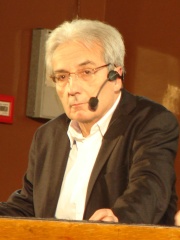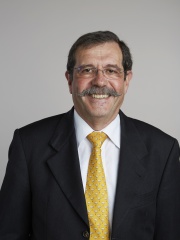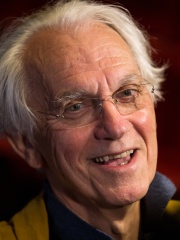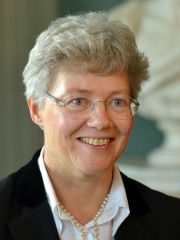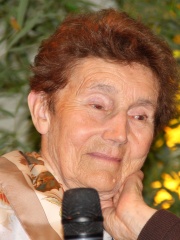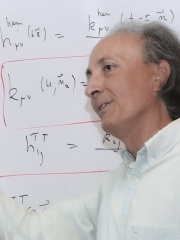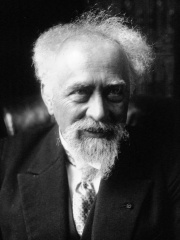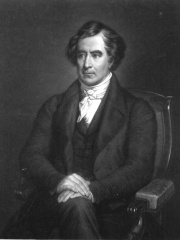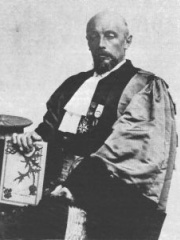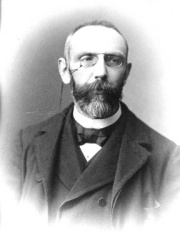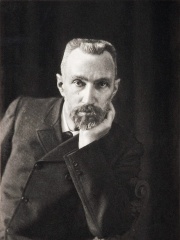
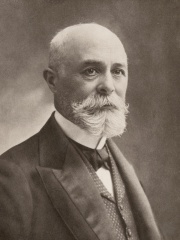

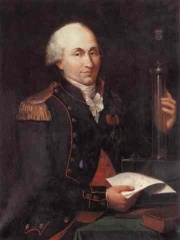
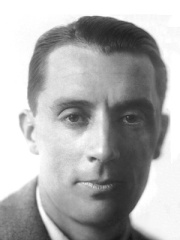
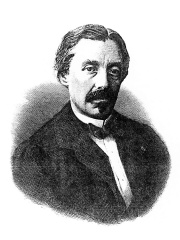
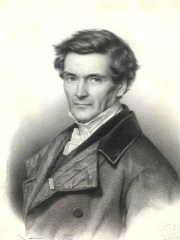
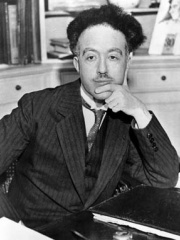
The Most Famous
PHYSICISTS from France
This page contains a list of the greatest French Physicists. The pantheon dataset contains 851 Physicists, 66 of which were born in France. This makes France the birth place of the 4th most number of Physicists behind Germany, and United Kingdom.
Top 10
The following people are considered by Pantheon to be the top 10 most legendary French Physicists of all time. This list of famous French Physicists is sorted by HPI (Historical Popularity Index), a metric that aggregates information on a biography’s online popularity. Visit the rankings page to view the entire list of French Physicists.

1. Pierre Curie (1859 - 1906)
With an HPI of 80.78, Pierre Curie is the most famous French Physicist. His biography has been translated into 113 different languages on wikipedia.
Pierre Curie ( KURE-ee, French: [pjɛʁ kyʁi]; 15 May 1859 – 19 April 1906) was a French physicist, a pioneer in crystallography, magnetism, piezoelectricity, and radioactivity. In 1903, he received the Nobel Prize in Physics with his wife, Marie Skłodowska–Curie, and Henri Becquerel, "in recognition of the extraordinary services they have rendered by their joint researches on the radiation phenomena discovered by Professor Henri Becquerel". With their win, the Curies became the first ever married couple to win the Nobel Prize, launching the Curie family legacy of five Nobel Prizes.

2. Henri Becquerel (1852 - 1908)
With an HPI of 79.12, Henri Becquerel is the 2nd most famous French Physicist. His biography has been translated into 103 different languages.
Antoine Henri Becquerel (; French pronunciation: [ɑ̃twan ɑ̃ʁi bɛkʁɛl]; 15 December 1852 – 25 August 1908) was a French engineer, physicist, Nobel laureate, and the first person to discover radioactivity. For work in this field he, along with Marie Skłodowska-Curie and Pierre Curie, received the 1903 Nobel Prize in Physics. The SI unit for radioactivity, the becquerel (Bq), is named after him.

3. André-Marie Ampère (1775 - 1836)
With an HPI of 79.07, André-Marie Ampère is the 3rd most famous French Physicist. His biography has been translated into 104 different languages.
André-Marie Ampère (UK: , US: , French: [ɑ̃dʁe maʁi ɑ̃pɛʁ]; 20 January 1775 – 10 June 1836) was a French physicist and mathematician who was one of the founders of the science of classical electromagnetism, which he referred to as "electrodynamics". He is also the inventor of numerous applications, such as the solenoid (a term coined by him) and the electrical telegraph. As an autodidact, Ampère was a member of the French Academy of Sciences and professor at the École polytechnique and the Collège de France. The SI unit of measurement of electric current, the ampere, is named after him. His name is also one of the 72 names inscribed on the Eiffel Tower.The term kinematic is the English version of His cinématique, which he constructed from the Greek κίνημα kinema ("movement, motion"), itself derived from κινεῖν kinein ("to move").

4. Charles-Augustin de Coulomb (1736 - 1806)
With an HPI of 77.33, Charles-Augustin de Coulomb is the 4th most famous French Physicist. His biography has been translated into 86 different languages.
Charles-Augustin de Coulomb (, KOO-lom, -lohm, koo-LOM, -LOHM; French: [kulɔ̃]; 14 June 1736 – 23 August 1806) was a French officer, engineer, and physicist. He is best known as the eponymous discoverer of what is now called Coulomb's law, the description of the electrostatic force of attraction and repulsion. He also did important work on friction. The SI unit of electric charge, the coulomb, was named in his honor in 1880.
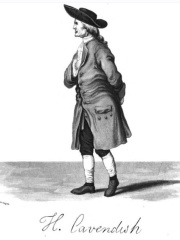
5. Henry Cavendish (1731 - 1810)
With an HPI of 74.43, Henry Cavendish is the 5th most famous French Physicist. His biography has been translated into 83 different languages.
Henry Cavendish ( KAV-ən-dish; 10 October 1731 – 24 February 1810) was an English natural philosopher and scientist who was an important experimental and theoretical chemist and physicist. He is noted for his discovery of hydrogen, which he termed "inflammable air". He described the density of inflammable air, which formed water on combustion, in a 1766 paper, On Factitious Airs. Antoine Lavoisier later reproduced Cavendish's experiment and gave the element its name. A shy man, Cavendish was distinguished for great accuracy and precision in his researches into the composition of atmospheric air, the properties of different gases, the synthesis of water, the law governing electrical attraction and repulsion, a mechanical theory of heat, and calculations of the density (and hence the mass) of the Earth. His experiment to measure the density of the Earth (which, in turn, allows the gravitational constant to be calculated) has come to be known as the Cavendish experiment.

6. Frédéric Joliot-Curie (1900 - 1958)
With an HPI of 73.04, Frédéric Joliot-Curie is the 6th most famous French Physicist. His biography has been translated into 71 different languages.
Jean Frédéric Joliot-Curie (French: [fʁedeʁik ʒɔljo kyʁi]; né Joliot; 19 March 1900 – 14 August 1958) was a French physicist and husband of Irène Joliot-Curie, with whom he was jointly awarded the Nobel Prize in Chemistry in 1935 for their discovery of induced radioactivity. They were the second ever married couple, after his wife's parents, to win the Nobel Prize, adding to the Curie family legacy of five Nobel Prizes. Joliot-Curie and his wife also founded the Orsay Faculty of Sciences, part of the Paris-Saclay University.

7. Léon Foucault (1819 - 1868)
With an HPI of 73.03, Léon Foucault is the 7th most famous French Physicist. His biography has been translated into 70 different languages.
Jean Bernard Léon Foucault (UK: , US: ; French: [ʒɑ̃ bɛʁnaʁ leɔ̃ fuko]; 18 September 1819 – 11 February 1868) was a French physicist best known for his demonstration of the Foucault pendulum, a device demonstrating the effect of Earth's rotation. He also made an early measurement of the speed of light, discovered eddy currents, and is credited with naming the gyroscope.

8. Gaspard-Gustave de Coriolis (1792 - 1843)
With an HPI of 70.70, Gaspard-Gustave de Coriolis is the 8th most famous French Physicist. His biography has been translated into 57 different languages.
Gaspard-Gustave de Coriolis (French: [ɡaspaʁ ɡystav də kɔʁjɔlis]; 21 May 1792 – 19 September 1843) was a French mathematician, mechanical engineer and scientist. He is best known for his work on the supplementary forces that are detected in a rotating frame of reference, leading to the Coriolis effect. He was the first to apply the term travail (translated as "work") for the transfer of energy by a force acting through a distance, and he prefixed the factor ½ to Leibniz's concept of vis viva, thus specifying today's kinetic energy.

9. Louis de Broglie (1892 - 1987)
With an HPI of 70.17, Louis de Broglie is the 9th most famous French Physicist. His biography has been translated into 93 different languages.
Louis Victor Pierre Raymond, 7th Duc de Broglie (, also US: , French: [də bʁɔj] or [də bʁœj] ; 15 August 1892 – 19 March 1987) was a French aristocrat and physicist who made groundbreaking contributions to quantum theory. In his 1924 PhD thesis, he postulated the wave nature of electrons and suggested that all matter has wave properties. This concept is known as the de Broglie hypothesis, an example of wave–particle duality, and forms a central part of the theory of quantum mechanics. De Broglie won the Nobel Prize for Physics in 1929, after the wave-like behaviour of matter was first experimentally demonstrated in 1927. The 1925 pilot-wave model, and the wave-like behaviour of particles discovered by de Broglie was used by Erwin Schrödinger in his formulation of wave mechanics. The pilot-wave model and interpretation was then abandoned, in favor of the quantum formalism, until 1952 when it was rediscovered and enhanced by David Bohm.Louis de Broglie was the sixteenth member elected to occupy seat 1 of the Académie française in 1944, and served as Perpetual Secretary of the French Academy of Sciences. De Broglie became the first high-level scientist to call for establishment of a multi-national laboratory, a proposal that led to the establishment of the European Organization for Nuclear Research (CERN).
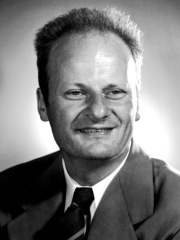
10. Hans Bethe (1906 - 2005)
With an HPI of 69.64, Hans Bethe is the 10th most famous French Physicist. His biography has been translated into 85 different languages.
Hans Albrecht Bethe (German pronunciation: [ˈhans ˈbeːtə] ; July 2, 1906 – March 6, 2005) was a German-American theoretical physicist who made major contributions to nuclear physics, astrophysics, quantum electrodynamics, and solid-state physics, and who won the 1967 Nobel Prize in Physics for his work on the theory of stellar nucleosynthesis. For most of his career, Bethe was a professor at Cornell University.During World War II, he was head of the Theoretical Division at the secret Los Alamos laboratory that developed the first atomic bombs. There he played a key role in calculating the critical mass of the weapons and developing the theory behind the implosion method used in both the Trinity test and the "Fat Man" weapon dropped on Nagasaki in August 1945. After the war, Bethe also played an important role in the development of the hydrogen bomb, although he had originally joined the project with the hope of proving it could not be made. Bethe later campaigned with Albert Einstein and the Emergency Committee of Atomic Scientists against nuclear testing and the nuclear arms race. He helped persuade the Kennedy and Nixon administrations to sign, respectively, the 1963 Partial Nuclear Test Ban Treaty and 1972 Anti-Ballistic Missile Treaty (SALT I). His scientific research never ceased and he was publishing papers well into his nineties, making him one of the few scientists to have published at least one major paper in his field during every decade of his career, which in Bethe's case spanned nearly seventy years. Freeman Dyson, once his doctoral student, called him the "supreme problem-solver of the 20th century".
People
Pantheon has 72 people classified as French physicists born between 1620 and 1958. Of these 72, 6 (8.33%) of them are still alive today. The most famous living French physicists include Albert Fert, Alain Aspect, and Gérard Mourou. The most famous deceased French physicists include Pierre Curie, Henri Becquerel, and André-Marie Ampère. As of April 2024, 6 new French physicists have been added to Pantheon including Anne L'Huillier, Jean Becquerel, and Prosper-René Blondlot.
Living French Physicists
Go to all RankingsAlbert Fert
1938 - Present
HPI: 66.21
Alain Aspect
1947 - Present
HPI: 64.18
Gérard Mourou
1944 - Present
HPI: 62.70
Anne L'Huillier
1958 - Present
HPI: 60.73
Hélène Langevin-Joliot
1927 - Present
HPI: 60.17
Thibault Damour
1951 - Present
HPI: 47.08
Deceased French Physicists
Go to all RankingsPierre Curie
1859 - 1906
HPI: 80.78
Henri Becquerel
1852 - 1908
HPI: 79.12
André-Marie Ampère
1775 - 1836
HPI: 79.07
Charles-Augustin de Coulomb
1736 - 1806
HPI: 77.33
Henry Cavendish
1731 - 1810
HPI: 74.43
Frédéric Joliot-Curie
1900 - 1958
HPI: 73.04
Léon Foucault
1819 - 1868
HPI: 73.03
Gaspard-Gustave de Coriolis
1792 - 1843
HPI: 70.70
Louis de Broglie
1892 - 1987
HPI: 70.17
Hans Bethe
1906 - 2005
HPI: 69.64
Jean Baptiste Perrin
1870 - 1942
HPI: 69.59
François Arago
1786 - 1853
HPI: 68.52
Newly Added French Physicists (2024)
Go to all RankingsAnne L'Huillier
1958 - Present
HPI: 60.73
Jean Becquerel
1878 - 1953
HPI: 50.11
Prosper-René Blondlot
1849 - 1930
HPI: 49.83
Marcel Brillouin
1854 - 1948
HPI: 49.30
Thibault Damour
1951 - Present
HPI: 47.08
Yvette Cauchois
1908 - 1999
HPI: 46.78
Overlapping Lives
Which Physicists were alive at the same time? This visualization shows the lifespans of the 25 most globally memorable Physicists since 1700.

